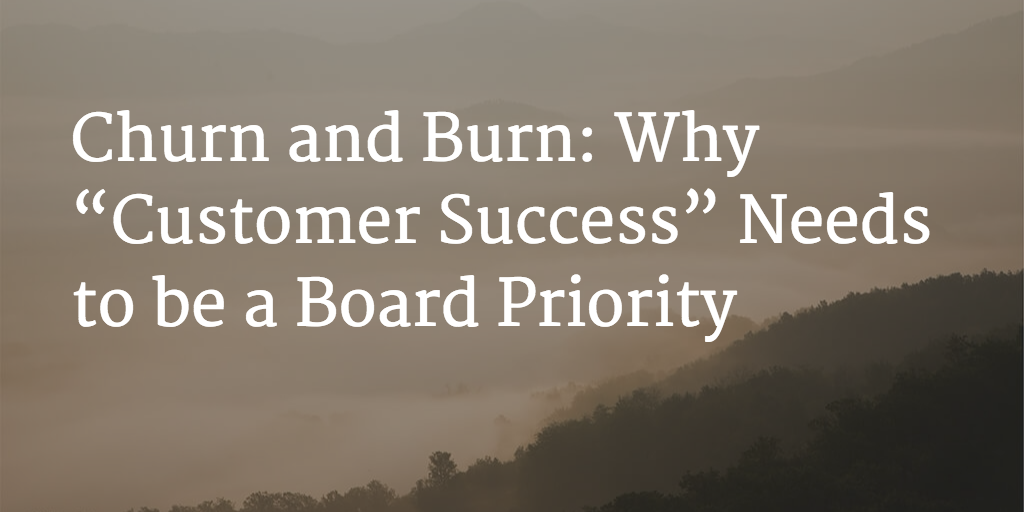I was sitting in a board meeting for one of my portfolio companies last month and two interesting things happened. First, the company reported it had zero customer churn (or 100% retention) in the quarter for the first time in its history.
Next, the company’s CEO shared a story about a panel at a conference at which he was asked to name his most important executive. The other panelists named obvious candidates, like their VPs of sales or engineering. This CEO, however, said his most important executive is his VP of customer success. His rationale? “If I can’t make my customers successful, nothing else matters.”
I tend to agree with him.
The notion of dedicating an entire position, let alone a department, to “customer success” at a company might seem silly or just glaringly obvious at first blush. What company doesn’t want their customers to be successful? But as most software companies have evolved over the last several years to embrace a subscription business model, I—and certainly the CEO described above—have concluded that customer success is a critical, and often under-used, tool for most modern start-ups.
Simply put, a subscription business model means customers must continually renew to keep revenue flowing into a company and create long-term, durable value. Most start-ups can convince a handful of customers to adopt a new technology and create an initial sense of sales momentum. But very few understand how to keep customers happy over time and keep them coming back for more.
As a member of several boards of directors, I actively promote the concept of customer success and encourage CEOs to focus on a few key metrics that are proxies for this over the long-term. Many of these metrics are outlined in my friend Nick Mehta’s paper “The Executive Guide to Churn” (The Elephant in the Board Room). I would encourage all CEOs and board members to read this document. There is a lot of wisdom in here.
However, one point worth emphasizing is that some customer-success metrics, in particular churn, are lagging indicators. CEOs and boards should focus just as much energy studying the customer behaviors yielding customer success, since they provide early-warning signs about customers’ happiness or dissatisfaction. Key questions to ask include:
- Are end customers actually using the product? How many times per week or month are your customers actually logging into your software?
- Is usage growing or decreasing on a per capita basis—in other words, how frequently is each user engaged? And on a gross basis, how many users are being added (or subtracted) every quarter?
- What is each customer’s Net Promoter score – is it growing or decreasing?
- Is the customer reference-able? Were they willing to serve as a reference in the past, but then stopped? That’s trouble.
- Are customers paying their bills on time? Are there payment patterns changing?
- Has your corporate sponsor left?
- Are customers using your most valuable and differentiated product features? You want customers to take full advantage of your product. If they’re not, they may be disengaged and in danger of not renewing.
The big takeaway here is that as a subscription company grows, renewals and upsells from the installed base will comprise the majority of both revenues and bookings over time. If you don’t see good trends with the customer-engagement behaviors I’ve listed above, your customers won’t renew. And if customers don’t renew at high levels (e.g., 90%+), you will have a leaky bucket that will have a very negative impact on your ability to grow revenue and equity value over time.
Consider the following simple example, outlined in Nick’s paper. Let’s say there are two companies, Company A and Company B, each picking up 10 new customers a month. Each customer pays a $1,000 per month subscription fee, and the customer acquisition cost for each one is $12,000. Things seem very similar, right?
Well, things change when one company takes customer success seriously and one does not. Assume Company A works hard and achieves a 95% customer-retention rate—but Company B is not as focused. It manages to retain only 80% of its customers. Over the long term, Company A sees a big payoff from customer success: In five years, it has acquired 600 customers, lost just 30 and boasts a $6.3 million revenue run rate, implying a $28.7 company valuation. Poor Company B is in worse shape: It acquired the same number of customers but lost many more—120—resulting in a $4.5 million run rate and a $13.7 million valuation. That’s $15 million less than Company A’s.
So the $15 million question is, how do I avoid the fate of Company B? Here are a couple of suggestions:
- Don’t wait to hire experts in customer success. Most companies wait too long to launch a customer-success organization, assuming sales or engineering can cover it. Big mistake. You want dedicated resources focused on customer success a few months before you even bring on your first customers. These staffers can clearly identify the processes and touch points for the successful adoption of your product.
- Your goal should be “100/100/100”. Meaning, you should focus on making your first 100 customers 100% reference-able and have them renew at a rate of 100%. You can’t invest too much in making your first 100 customers successful; they‘ll help you get your next 1,000 customers by acting as strong references and providing very positive word of mouth support. Don’t worry too much about scaling/efficiency at this point in your lifecycle – that can be solved later.
- Allocate some portion of your executive compensation/bonus plan to renewals and customer reference-ability from day one. You want to build customer success into your culture early.
It’s impossible to maintain a long-term rate of no customer churn, as my customer success-focused CEO did in the just-ended quarter. But if board members encourage CEOs to make customer-success a priority, they can keep rates low and build more valuable businesses over time.
